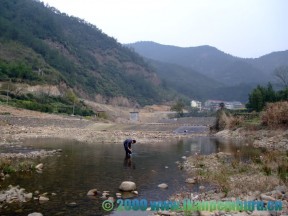Rhinogobius lentiginis
SynonymsTop ↑
Ctenogobius lentiginis Wu & Zheng, 1985
Etymology
Rhinogobius: from the Greek rhinos, meaning ‘nose’, and the generic name Gobius.
lentiginis: appears to be derived from the Latin lens, meaning ‘a lentil bean’ with the modern derivation lentigo meaning ‘a spot on the skin, freckle’.
Classification
Order: Perciformes Family: Gobiidae
Distribution
Appears endemic to Zhejiang province, eastern China with records existing from the Cheng-Tang, Ling, and O river systems.
Type locality is ‘Taintai County at Lingjiang River, 29°N, 121°20’E, China’.
Habitat
Inhabits smaller rivers, tributaries and streams with substrates of gravel, rocks, boulders, and exposed bedrock which undergo seasonal variations in water flow rate, depth and turbidity.
Maximum Standard Length
The largest officially-recorded specimen measured 32 mm.
Aquarium SizeTop ↑
An aquarium with base dimensions of 60 ∗ 30 cm should prove large enough to house a small group.
Water Conditions
Temperature: 16 – 24 °C
pH: 6.0 – 8.0
Hardness: 36 – 268 ppm
Diet
Rhinogobius spp. tend to be opportunistic carnivores feeding on a range of small invertebrates, crustaceans and similar in nature.
In the aquarium they should be offered small live or frozen foods such as chironomid (bloodworm) or mosquito larvae, Artemia, Daphnia, Mysis, etc.
Dried foods may be accepted following a period of acclimatisation but should not be used regularly.
Sexual Dimorphism
Images would suggest that males develop extended rays in the first dorsal-fin.
NotesTop ↑
It’s unlikely that this species has been in the aquarium hobby given its natural range and the lack of commercial fishing for the ornamental trade in that area.
Among congeners it’s most similar to R. davidi but can be told apart by presence of 8 (vs. always 9 in R. davidi) soft dorsal-fin rays, 10 (vs. 11-12) transverse scale rows, and 6-7 (vs. 8-10) scales between the first dorsal-fin origin and upper pectoral-fin base.
In addition R. lentiginis possesses a number of irregular dark blotches and spots on the cheek and opercle, vs. a single, dark vertical stripe in R. davidi and lacks, vs. possesses, cephalic lateralis canals.
The Gobiidae is the most speciose vertebrate family and notoriously problematic in terms of identifying fishes down to species level.
Within this sizeable assemblage Rhinogobius is often included in the subfamily Gobionellinae alongside genera such as Brachygobius, Chlamydogobius, Mugilogobius, Pseudogobiopsis, Schismatogobius, and Stigmatogobius.
Members can be told apart from these and all other gobiid genera by the following combination of characters: head with four simple, longitudinal infraorbital sensory papilla rows a, b, c, and d, single cp papilla, and paired papillae in mental row f; head canal variable from complete loss to normal development of anterior and posterior oculoscapular canals, and preopercular canals, and always with double interorbital pores λ if the pore is present; body mostly covered with ctenoid scales; longitudinal scale series 25–42; head including cheek, snout, opercle, anterior part of nape as well as pre-pectoral region all naked; D1 usually VI; D2 I, 6–11; A I, 5–11; P 14–23; and V I, 5 + I, 5, forming a rounded disc with frenum present, performing two pointed spinous lobes, the spinous ray usually longer than the first branched ray; dorsal pterygiophore formulae modally 3–22 1 101; vertebrae 25–29, usually 26 for most landlocked species.
The genus is widely-distributed throughout much of continental Asia in Russia, Korea, China, Vietnam, Laos, Cambodia, and Thailand, plus numerous islands of the Western Pacific including Japan, Taiwan, Hainan, and the Philippines.
There currently exist over 60 recognised species with many more awaiting formal description, and a number of the described ones are only considered nominal taxa pending additional study.
Those exhibiting similarities in appearance, morphology and behaviour are therefore often aggregated in nominal species groups, e.g., the R. brunneus group, R. duospilus group, etc., for ease of reference.
The fused pelvic fins form a structure normally referred to as the ‘pelvic disc’, a common feature among gobiids which is used to adhere to rocks and other submerged surfaces.
Rhinogobius spp. also exhibit different reproductive strategies depending on environment, with those inhabiting rivers connected directly to the sea typically amphidromous, and those landlocked in upper reaches of rivers or lakes non-diadromous.
Many of those appearing in the aquarium trade have proven difficult to identify for a number of reasons including:
– taxonomic confusion.
– lack of aquarium literature.
– incorrect labelling by exporters and subsequently shops.
– historical over-use of some names, e.g., ‘Rhinogobius wui‘ which is itself an invalid synonym of R. duospilus.
– likely trade of undescribed species without locality data.
– mixing of species at export facilities.
References
- Chen, I-S. and P. J. Miller, 1998 - Cybium 22(3): 211-221
Redescription of a Chinese freshwater goby, Gobius davidi (Gobiidae), and comparison with Rhinogobius lentiginis. - Chen, I-S., H.-L. Wu and K.-T. Shao, 1999 - Ichthyological Research 46(2): 171-178
A new species of Rhinogobius (Teleostei: Gobiidae) from Fujian Province, China. - Chen, I-S., Y.-H. Cheng and K.-T. Shao, 2008 - Ichthyological Research 55(4): 335-434
A new species of Rhinogobius (Teleostei: Gobiidae) from the Julongjiang basin in Fujian Province, China. - Li, F. and J.-S. Zhong, 2007 - Zoological Research 28(5): 539-544
A new Rhinogobius species from Zhejiang Province, China (Teleostei: Gobiidae). - Yang, J.-Q., H.-L. Wu and I-S. Chen, 2008 - Ichthyological Research 55(4): 379-385
A new species of Rhinogobius (Teleostei: Gobiidae) from the Feiyunjiang Basin in Zhejiang Province, China.



